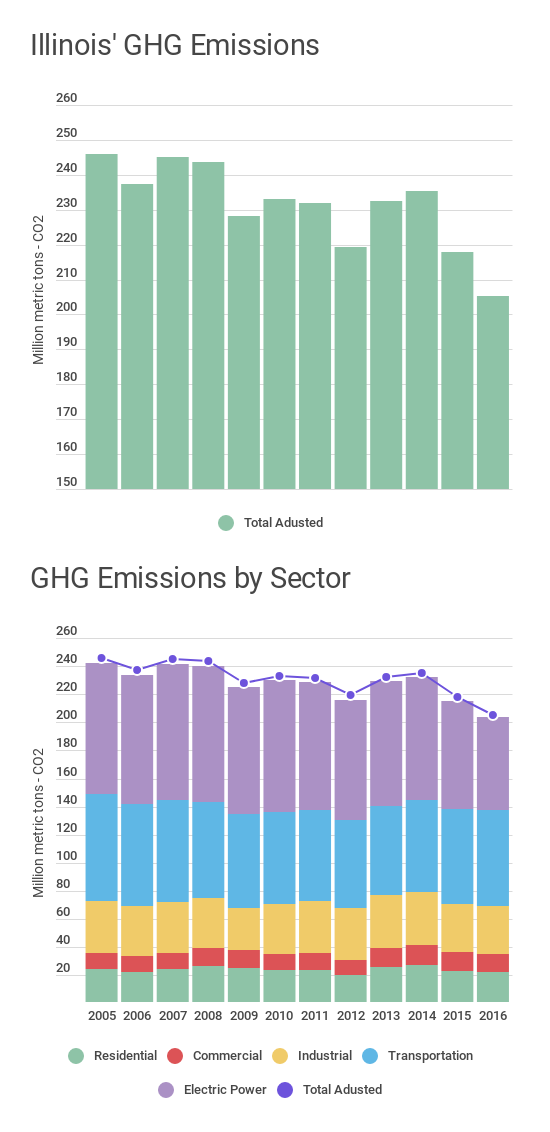U.S. Climate Alliance
On January 23, 2019, Governor Pritzker signed Executive Order 2019-06 entering Illinois in the U.S. Climate Alliance (Alliance), a group of states committed to reducing greenhouse gas (GHG) emissions consistent with the United Nations Paris Agreement (the Agreement).
Every Alliance member commits to:
- Implement policies that advance the goals of the Paris Agreement, aiming to reduce GHG emissions by at least 26-28 percent below 2005 levels by 2025.
- Track and report progress to the global community in appropriate settings, including when the world convenes to take stock of the Paris Agreement.
- Accelerate new and existing policies to reduce carbon pollution and promote clean energy deployment at the state and federal level.
Governor Pritzker identified Illinois EPA as the lead agency to coordinate Illinois’ climate policies. A significant number of Illinois EPA programs can reduce energy demand, and quantify and mitigate impacts of climate change. Other statewide programs implemented by other state agencies also are having a positive impact at reducing the state’s GHG emissions.
Alliance Commitments
1. Implement policies that advance the goals of the Paris Agreement, aiming to reduce greenhouse gas emissions by at least 26-28 percent below 2005 levels by 2025.
Illinois is currently on track to meet this goal. As reported by the U.S. Energy Information Administration, Illinois CO2 emissions from all sectors declined from a high of 242.0 million metric tons of CO2 in 2005 to 204.1 million metric tons of CO2 in 2016 (the most recently reported year) a 16.7 percent decrease. Significantly, there was an almost 30 percent decline in GHG emissions from the electric power sector. The Residential, Commercial, Industrial and Transportation sectors were generally flat or experienced only slight declines. The Transportation sector is now the largest emitter of GHG emissions in Illinois.
It can be assumed that the retirement of several coal-fired power plants, increased reliance on natural gas fired electrical generation, and a large increase in renewable energy generation contributed to these positive results in the electric power sector. Stabilization of the nuclear fleet as a zero GHG emission source through the Future Energy Jobs Act (FEJA) should also help Illinois achieve the Agreement goals. Illinois EPA will gather and consolidate information and work with external agencies to further develop forecasting of greenhouse gas reductions.

2. Track and report progress to the global community in appropriate settings, including when the world convenes to take stock of the Paris Agreement.
Member states prepare a factsheet reporting on goals, metrics and programs that it implements and supports to achieve GHG reductions, and this factsheet is updated annually. As to quantifying GHG emissions, the Illinois EPA’s Bureau of Air will refine its GHG inventory and will cross-verify the inventory against information provided at the federal level, such as U.S. EPA and the Energy Information Administration.
3. Accelerate new and existing policies to reduce carbon pollution and promote clean energy deployment at the state and federal level.
Other state agencies implement climate-related programs and gather information independently. Working together, state agencies can more fully and efficiently meet Illinois’ goals for climate change mitigation and resilience.
The Future Energy Jobs Act (FEJA) became effective on June 1, 2017. FEJA supports zero emission energy generation, and drives energy efficiency, renewable energy production, energy support for low-income communities, and clean energy job training.
- FEJA Solar Training Programs (Illinois Department of Commerce & Economic Opportunity)
Additional Resources
Climate and Equitable Jobs Act
Energy Rebates

